It all started around 1520, in a dangerous silver mine, where radiation -coming from uranium- frequently caused the miners serious diseases, and even death. Nevertheless, it was very productive and enough ore was mined to mint high quality coins, with high material value, impossible to counterfeit, characteristics that spread those coins throughout Europe for centuries.
In German, the valleys are distinguished by a suffix, "thal" which is pronounced "dal". The valley where the silver was extracted for the old coins was the "St. Joachimsthal" that is, the Saint Joachim's Valley.

In Saxon languages, the subject that comes from, or is relative to, is defined by another suffix "er". Thus, each currency that came from there was called "Joachimsthaller". Daily use led to shortened the word eliminated the first part, "Joachim", leaving only the final part, with what was the use what coined the term "thaller" pronounced "dollar".

Over time, many other currencies were named that way, being "Maria Theresa Thaler" being one of the most widely known. With the conquest of the new continent, Spain began the exploitation of silver mines in Mexico, Peru and Bolivia, having enormous quantities of the precious metal, used to mint a coin that, by its extensive distribution, spanned from Europe to China: the Spanish Peso.
Its distribution and importance in the commercial exchange was such that it was commonly used within the territory of the British colonies of North America, due to the shortage of British coins. On several occasions different colonies issued their own paper money, and the consequent disputes with the British government because of this were one of the causes of the American Revolution. The rebels financed their war largely by printing bills that were called Continental. By the end of the war, these had lost almost all their value due to hyperinflation. However, they had justified their existence and with the help of the French allies, the Americans won.
By entering the War of Independence against England, Americans required large amounts of "Spanish dollars" to mobilize all the logistics of a war economy. Logically, in the inscriptions of the "Spanish Peso" there was no "Dollar" written anywhere, but it was widely known as "Spanish Dollar" by the English speakers from British Colonies.
Once the independence of the United States was declared, it was decided that the official currency would be the "Dollar", becoming the most widely distributed currency in the world.
Inspired by preserving the main characteristics of the precursor dollars of the Bohemian valley: quality, impossibility to be falsified, as well as the wide distribution of the Spanish dollar at the time of the conquest of America, and the economic power of the current US dollars, a select group of developers offers the world an innovative concept and presents the Electronic Dollar (eDollar - EDL). Unlike the main crypto-currencies that exist today, this new concept also integrates the guarantee of anonymity that prevents the display of the balance sheets of those who participate in exchanges for unauthorized eyes, as well as the own amounts of each transaction.

Do you want to meet this project and even safely mine EDL coins with your personal computer´s CPU?
Fine! Just visit eDollar homepage at https://edollar.cash/
And by completing this form, you can even receive some free EDL during the 3rd Airdrop: https://goo.gl/forms/gCP10eI7eUt3s7B63
Source:
https://www.britannica.com/place/Jachymov#ref842186
Davies, Glyn. A history of money from ancient times to the present day, 3rd ed. Cardiff: University of Wales Press, 2002. 720 pages. Paperback: ISBN 0 7083 1717 0.